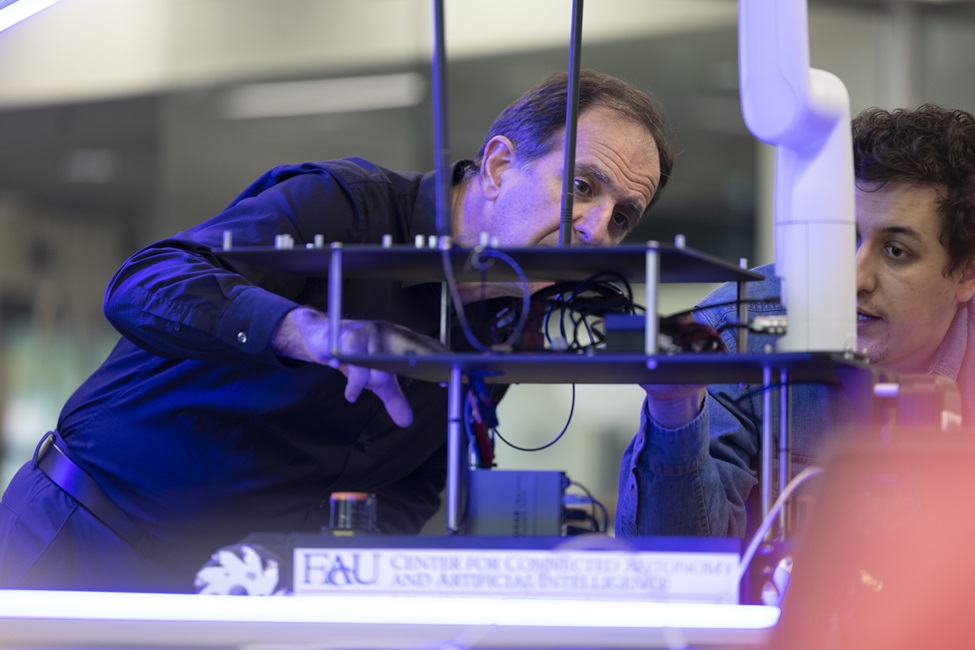FAU CA-AI Research Highlighted in 'Nature Reviews'

(Photo by Alex Dolce)
Florida Atlantic Center for Connected Autonomy and Artificial Intelligence (CA-AI.fau.edu) researchers “cracked the code” on interference when machines need to talk with each other – and people. Electromagnetic waves make wireless connectivity possible but create a lot of unwanted chatter. Referred to as “electromagnetic interference,” this noisy byproduct of wireless communications poses formidable challenges in modern day dense Internet of Things and AI robotic environments. With the demand for lightning-fast data rates reaching unprecedented levels, the need to quell this interference is more pressing than ever.
Equipped with a breakthrough algorithmic solution, researchers from FAU Center for Connected Autonomy and AI, within the College of Engineering and Computer Science , and FAU Institute for Sensing and Embedded Network Systems Engineering (I-SENSE), have figured out a way to do that. Their method, which is a first, dynamically fine-tunes multiple-input multiple-output (MIMO) links, a cornerstone of modern-day wireless systems such as Wi-Fi and cellular networks.
The researchers’ game changing approach, just published in a special issue of the journal of the Institute of Electrical and Electronics Engineers (IEEE) on electromagnetics and information theory and immediately featured as a research highlight in “Nature Reviews,” demonstrates how their algorithmic method sculpts wireless waveforms to navigate the crowded frequency band. By simultaneously optimizing transmission in space and time, this algorithm could pave the way for pristine communication channels.
In field demonstrations, the researchers dynamically optimized MIMO wireless waveform shapes over a given frequency band to manage and avoid interference in machine-to-machine communications and showed the effectiveness of this method in real-world scenarios where interference is a common problem.
“We have pioneered the conceptual and practical groundwork for machines outfitted with multiple antennas to autonomously determine the most effective waveform shapes in both time and space domains for communication within a designated frequency band, even among extremely challenging interference and disturbances,” said Dimitris Pados, Ph.D., senior author, professor, director of the CA-AI and a fellow of I-SENSE in the Department of Electrical Engineering and Computer Science. “By employing dynamic waveform machine learning in tandem across space and time, we believe that we have ‘cracked the code’ on mitigating electromagnetic interference.”
Researchers first conducted extensive simulations to validate the efficacy of this method against a barrage of interference scenarios from near-field to far-field and in both light and dense interference scenarios. These simulations highlighted the ability of the optimized waveforms, particularly joint space-time optimization, to maintain “clean” communications in extreme mixed-interference environments.
“In the realm of autonomous systems and machine-to-machine communications, secure, reliable and ‘clean’ communications are paramount, underscoring the importance of this breakthrough research at Florida Atlantic,” said Stella Batalama, Ph.D., dean, FAU College of Engineering and Computer Science. “In the midst of chaos in modern communication, this innovative research offers a very promising avenue to address interference challenges in machine-to-machine communications where there are high volumes of devices and multiple networks.”
Study co-authors of the IEEE journal publication are Sanaz Naderi, first author and graduate research assistant; and George Sklivanitis, Ph.D., Schmidt Research Associate Professor and I-SENSE fellow; within the FAU College of Engineering and Computer Science; and Elizabeth Serena Bentley, Ph.D.; Joseph Suprenant; and Michael J. Medley, Ph.D., all with the United States Air Force Research Laboratory.
-FAU-
Latest News Desk
- FAU Hosts ABC's 'Sharks' for First-of-its-Kind CompetitionThe judges of ABC's "Shark Tank" will be coming to Florida Atlantic University for its very own CrocTank, the first-of-its-kind live event on Dec. 4 at the Carole and Barry Kaye Performing Arts Auditorium.
- Arslan Munir, Ph.D., Pioneer in Smart Technologies, Joins FAUThe FAU College of Engineering and Computer Science recently welcomed Arslan Munir, Ph.D., an internationally renowned expert, researcher and pioneer in advanced computing and smart technologies.
- VR Could be a Gamechanger in Police-Civilian Crisis EncountersAn FAU College of Social Work and Criminal Justice study immersed police officers in virtual reality training using a realistic mental illness scenario to enhance empathy and complement traditional training.
- STEM Teachers in High-need Schools Resilient Despite ChallengesAn FAU College of Education researcher collaborated on a study examining 30 years of STEM teacher trends, focusing on qualifications and changes in high-need, primarily high-poverty U.S. schools.
- Alcohol-Related Deaths in the U.S. More than Double from 1999 to 2020FAU researchers explored overall trends as well as by age, gender, race and region. The sharpest spike occurred among 25-34-year-olds (nearly fourfold), while individuals aged 55-64 had the highest rates.
- Hyman Science Lecture Series at FAU Hosts Journalist Carl ZimmerThe Nat and Dorothy Hyman Science Lecture Series, as part of the Schmidt College of Science at FAU, will host science journalist Carl Zimmer on Thursday, Nov. 21 at 5:30 p.m.






